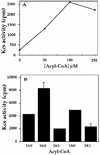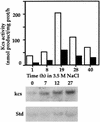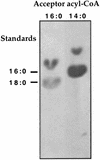Salt induction of fatty acid elongase and membrane lipid modifications in the extreme halotolerant alga Dunaliella salina
- PMID: 12114585
- PMCID: PMC166525
- DOI: 10.1104/pp.001909
Salt induction of fatty acid elongase and membrane lipid modifications in the extreme halotolerant alga Dunaliella salina
Erratum in
- Plant Physiol. 2003 Jun;132(2):1115
Abstract
In studies of the outstanding salt tolerance of the unicellular green alga Dunaliella salina, we isolated a cDNA for a salt-inducible mRNA encoding a protein homologous to plant beta-ketoacyl-coenzyme A (CoA) synthases (Kcs). These microsomal enzymes catalyze the condensation of malonyl-CoA with acyl-CoA, the first and rate-limiting step in fatty acid elongation. Kcs activity, localized to a D. salina microsomal fraction, increased in cells transferred from 0.5 to 3.5 M NaCl, as did the level of the kcs mRNA. The function of the kcs gene product was directly demonstrated by the condensing activity exhibited by Escherichia coli cells expressing the kcs cDNA. The effect of salinity on kcs expression in D. salina suggested the possibility that salt adaptation entailed modifications in the fatty acid composition of algal membranes. Lipid analyses indicated that microsomes, but not plasma membranes or thylakoids, from cells grown in 3.5 M NaCl contained a considerably higher ratio of C18 (mostly unsaturated) to C16 (mostly saturated) fatty acids compared with cells grown in 0.5 M salt. Thus, the salt-inducible Kcs, jointly with fatty acid desaturases, may play a role in adapting intracellular membrane compartments to function in the high internal glycerol concentrations balancing the external osmotic pressure.
Figures





Similar articles
-
Substrate specificity of Arabidopsis 3-ketoacyl-CoA synthases.Biochem Biophys Res Commun. 2006 Jul 28;346(2):583-90. doi: 10.1016/j.bbrc.2006.05.162. Biochem Biophys Res Commun. 2006. PMID: 16765910
-
A jojoba beta-Ketoacyl-CoA synthase cDNA complements the canola fatty acid elongation mutation in transgenic plants.Plant Cell. 1996 Feb;8(2):281-92. doi: 10.1105/tpc.8.2.281. Plant Cell. 1996. PMID: 8742713 Free PMC article.
-
Increase in nervonic acid content in transformed yeast and transgenic plants by introduction of a Lunaria annua L. 3-ketoacyl-CoA synthase (KCS) gene.Plant Mol Biol. 2009 Mar;69(5):565-75. doi: 10.1007/s11103-008-9439-9. Epub 2008 Dec 11. Plant Mol Biol. 2009. PMID: 19082744
-
Extending the story of very-long-chain fatty acid elongation.Plant Sci. 2013 Sep;210:93-107. doi: 10.1016/j.plantsci.2013.05.008. Epub 2013 May 22. Plant Sci. 2013. PMID: 23849117 Review.
-
Structural classification and properties of ketoacyl synthases.Protein Sci. 2011 Oct;20(10):1659-67. doi: 10.1002/pro.712. Protein Sci. 2011. PMID: 21830247 Free PMC article. Review.
Cited by
-
Transcriptomic profiles of Dunaliella salina in response to hypersaline stress.BMC Genomics. 2020 Feb 3;21(1):115. doi: 10.1186/s12864-020-6507-2. BMC Genomics. 2020. PMID: 32013861 Free PMC article.
-
Comparative studies of four cumin landraces grown in Egypt.Sci Rep. 2024 Apr 5;14(1):7990. doi: 10.1038/s41598-024-57637-3. Sci Rep. 2024. PMID: 38580717 Free PMC article.
-
A Review on the Assessment of Stress Conditions for Simultaneous Production of Microalgal Lipids and Carotenoids.Front Microbiol. 2016 May 3;7:546. doi: 10.3389/fmicb.2016.00546. eCollection 2016. Front Microbiol. 2016. PMID: 27199903 Free PMC article. Review.
-
The role of photo-osmotic adaptation in semi-continuous culture and lipid particle release from Dunaliella viridis.J Appl Phycol. 2015;27(1):109-123. doi: 10.1007/s10811-014-0331-5. Epub 2014 May 13. J Appl Phycol. 2015. PMID: 25620852 Free PMC article.
-
Exogenously Supplemented Proline and Phenylalanine Improve Growth, Productivity, and Oil Composition of Salted Moringa by Up-Regulating Osmoprotectants and Stimulating Antioxidant Machinery.Plants (Basel). 2022 Jun 11;11(12):1553. doi: 10.3390/plants11121553. Plants (Basel). 2022. PMID: 35736704 Free PMC article.
References
-
- Al-Hasan R, Ghannoum M, Sallal A, Abu-Elteen K, Radwan S. Correlative changes of growth, pigmentation and lipid composition of Dunaliella salina in response to halostress. J Gen Microbiol. 1987;133:2607–2616.
-
- Avron M. The osmotic components of halotolerant algae. Trends Biochem. 1986;11:5–6.
-
- Bligh EG, Dyer WJ. A rapid method of total lipid extraction and purification. Can J Biochem Physiol. 1959;37:911–917. - PubMed
Publication types
MeSH terms
Substances
Associated data
- Actions
LinkOut - more resources
Full Text Sources

